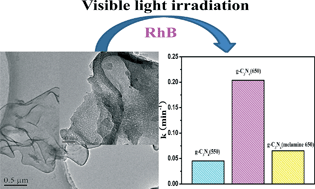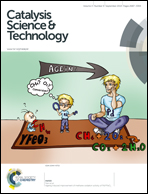Polycondensation of guanidine hydrochloride into a graphitic carbon nitride semiconductor with a large surface area as a visible light photocatalyst
Abstract
A low-cost, widely available and environmentally benign compound guanidine hydrochloride was applied to prepare g-C3N4 by thermal-induced polymerization at different temperatures. The as-prepared g-C3N4 was thoroughly characterized by X-ray diffraction, Fourier transform infrared spectroscopy, elemental analyses, N2 adsorption–desorption isotherms, thermal gravimetric analysis and differential scanning calorimetry, transmission electron microscopy, UV-vis diffuse reflectance spectra and photoluminescence spectra. It was noticeable that g-C3N4 prepared from guanidine hydrochloride possessed a much larger surface area than that prepared from melamine. And its photocatalytic activity was evaluated for degrading Rhodamine B dye which demonstrated that the g-C3N4 synthesized from guanidine hydrochloride exhibited a much higher activity than that prepared from melamine. Moreover, the activity can be further enhanced by increasing the condensation temperature of g-C3N4. In addition, the as-prepared g-C3N4 was also stable as demonstrated in the recycling experiments.


 Please wait while we load your content...
Please wait while we load your content...